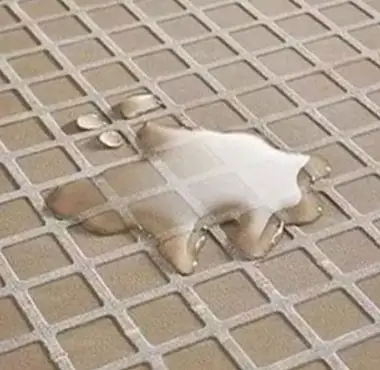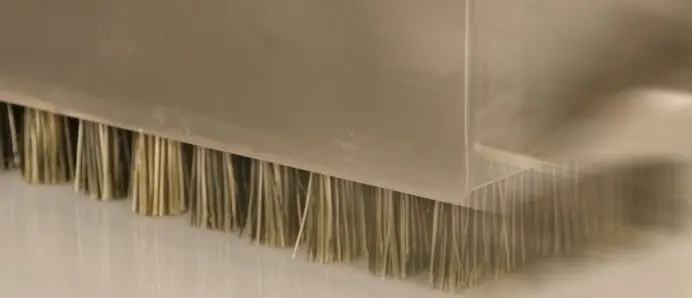How Can You Differentiate Between Porcelain & Ceramic Tiles!
If you have made up your mind to go for Porcelain tiles instead of any other option for flooring like marble, granite or terrazzo etc. for your home, you must know what makes up a good quality Porcelain tile. Here we are giving you some orientation to the quality parameters of Porcelain Floor Tiles so that you can ask the right questions to your seller.

It is unfortunate that a big trust deficit exists between the buyer and seller in Pakistan and that too for genuine reasons. You never know if the products being sold are genuine or not. Same goes true for Porcelain or ceramic tiles. The matter is not just limited to good quality or bad quality; the products can be altogether fake. This applies specially to Porcelain Tiles. We have witnessed that Ceramic or other material is being sold with the name of Porcelain to the unsuspecting buyers. Therefore, we think it is absolutely necessary that we apprise our subscribers as to what caution they should exercise when buying Porcelain tiles and enable you to spot fake or poor-quality Porcelain Floor Tiles. You need to understand the following:
- The Problem Identification
- The Applicable Quality Standards
- Self-help Testing Methods
The physical characteristics and quality parameters of Porcelain Tiles are defined by relevant quality standards like ISO, Euronorm or ASTM etc. These standards are quite detailed and complex. These are not easily comprehensible for most of the people especially those who do not have technical background. Even if you read these standards, still there is no easy way to determine the veracity of the claim of the manufacturer because you do not have all the facilities at your disposal to test the tiles. Although, there are construction materials testing laboratories everywhere that can test the tiles for quality but the process is time taking and expensive.
One way forward is to look at quality parameters printed on the packaging and compare those values with the standards like ISO, ASTM or Pakistan Standards etc. The story does not end here because the manufacturer may have printed just what is defined in the standards but the tiles actually do not meet those parameters. What will you do in that situation?
In the following sections we have provided simplified description of quality parameters and given some basic tips whereby you can determine the quality of Porcelain tiles and also evaluate whether tiles being sold to you are genuine or fake Porcelain. Let’s go…..
1. Water absorption
Water absorption test is the most reliable and quickest way to assess the quality of Porcelain Tiles. Porcelain is a very dense material which means that its particles are very tightly bound which make it resistant to penetration of water. Therefore, it will absorb very little or no water even after prolonged contact. Porcelain tiles have a water absorption rate of <5% of their weight.

Since, Porcelain is denser than Ceramic, it weighs heavier too. You can somewhat evaluate if the Porcelain tile which is being sold to you, is genuine or not, by weighing it.
Now here is simple test that you can perform on these Porcelain Tile pieces at home. Boil these pieces in water for a couple of hours and let them stay immersed for 24 hrs. After 24 hours, weigh them individually. Now the heaviest weighing is poorer quality because it has absorbed more water than the rest. The weight increase of good quality porcelain tile should not be more than 0.5% of its gross dry weight. Remember, more than that 0.5% weight increase due to water absorption is not a characteristic of good quality porcelain.
On the other hand, Ceramic Tiles have less dense body composition which renders them more porous which means that ceramic tiles have less strength, are more water absorbent, therefore, less durable than porcelain tiles. Ceramic tiles have a water absorption rate of over 10% of their weight. Here again you can apply the same test procedure as described above to know the difference between good and/or poor quality of ceramic tiles. This test should also help you determine the difference between Porcelain Floor Tiles and Ceramic Floor Tiles.
2. Chemical Resistance

Genuine Porcelain is resistance to chemical interactions. The routinely used house-hold cleaning chemicals like bleach or ammonia should not quickly erode the surface of the Porcelain Tiles. Poor quality Porcelain or fake Porcelain will be quickly stained by the ordinary cleaning chemical. You can test the quality of Tiles by applying cleaning chemical to various pieces of tiles and leaving them for 48 hours. Whichever piece shows signs of staining, discoloring and/or crazing, is not genuine Porcelain.
3. Resistance to Surface Abrasion

Good quality Porcelain resists surface abrasion over a long period of time which allows its use in high traffic areas. To determine the abrasion resistance, apply even number of rubbing strokes with a sand paper to various brands of Porcelain Tiles. All the pieces of tiles should be the same specification i.e. all pieces should either be glazed or matt or wood textured floor tiles.
Genuine Porcelain Tile, even after surface abrasion, will retain its design pattern beneath the surface also but a fake Porcelain Tile will completely lose its surface pattern and show a different texture and color beneath. Besides, whichever piece of Porcelain tile shows deeper signs of abrasion is obviously poorer in quality. Remember this is not standard way of testing abrasion resistance but only something that you can do by yourself.
On the other hand, Ceramic Floor Tiles have their design printed merely on their surface. A little bit of surface abrasion or chipping will reveal its natural color beneath the surface.
4. Reflection Test:

Porcelain Floor tiles have much smoother surface. Therefore, these tiles reflect sharper image as compared to marble and ceramic tiles. As per ASTM, to test the quality of porcelain tile, “hold it at a distance of 350 ± 100 mm from light source so that image of the lamp is reflected on the surface of tile. The angle of incidence of the light upon the surface should be approximately 45°. See how sharp is the image.” The criterion of judgement should be the sharpness of the reflection, not the brightness of the surface. The sharper the image, the better quality of porcelain it is.
5. Appearance of Porcelain Tiles
Another important factor that sets good quality Porcelain Tiles apart from poor quality or Fake Porcelain is their appearance. Porcelain’s color or design is carried through its entire body which means that even if a Porcelain Tile is chipped off or just wears out because of traffic, it still retains its pattern/design despite loss of surface sheen.
Ceramic Tile’s designs and colors are printed on the surface and protected with a type of glaze. If these tiles are chipped or surface wears out, it’ll be more noticeable since the body of the tile is a different color than the surface.
Another way is the pencil test i.e. draw some lines on the surface of the tile and try to remove them with a wet cloth. If the pencil marks are removed easily, it’s a good quality porcelain tile.
These are some of the basic tips to help you buy better tiles. Our purpose in this article is not to compare any manufacturer with another or compare porcelain with ceramic but to enable you to be safe from any attempted fraud. We hope that it is helpful.
You can see different kitchen designs on our website and watch different videos about it on your YouTube channel.


